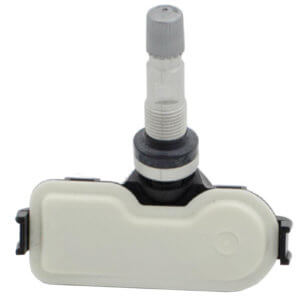Dodge TPMS
Dodge TPMS systems
Dodge TPMS systems
In 2009 models, Dodge TPMS uses two systems: base and premium
Dodge TPMS base system
The base system alerts the driver when one or more driving  tires are low (the spare is not monitored). If more than one tire is low, the base system cannot tell the driver that information. The pressure sensors are located in the valve stem. The sensors transmit to the central receiver located in the wireless ignition node (WIN).
tires are low (the spare is not monitored). If more than one tire is low, the base system cannot tell the driver that information. The pressure sensors are located in the valve stem. The sensors transmit to the central receiver located in the wireless ignition node (WIN).
Dodge premium TPMS system
The premium TPM system also has pressure sensors in each wheel. But it also has wheel sensor transponders in three of the four wheel wells. The system also includes an electronic display inside the cabin.
The Tire Pressure Monitoring (TPM) system monitors air pressure in the four road tires (excludes spare). Pressure in the spare tire is not monitored. The premium system can tell you which tire is low
How the premium Dodge TPMS system works
The wheel well transponders are also called trigger modules. They are used to provide location information to the WIN. The system only needs three sensors because once it communicates with three, it automatically knows the location of the fourth. The three transponders are located in the left front, left rear, and right front wheel wells
The WIN will store all warning and fault conditions, placard pressure values and low-pressure threshold values (lamp ON and OFF) in memory that can be accessed through diagnostic communication. If new sensors are introduced to the vehicle, the data stored for the sensor being replaced will be deleted.
The WIN will store all wheel sensor ID’s and locations and faults in memory that can be accessed through diagnostic communication. All other data values transmitted from each active wheel sensor (not the spare tire) shall be stored in the WIN memory.
The WIN automatically learns and stores the sensor IDs while driving “within 20 minutes continuously above 15 mph (24 km/h)” after a sensor has been replaced. The learning sequence will initiate when the vehicle has been stopped for more than 20 minutes.
The TPM sensors monitor the air pressure and temperature in the tire, as well as battery status and radial acceleration rate of the wheel. The sensor transmits the data at regular intervals as long as vehicle speed exceeds 15MPH.
The WIN logs a loss of signal error if eight consecutive blocks of data aren’t received or properly decoded within a 10-min. time period. The WIN will set an error condition if it detects a problem with the pressure sensor, temperature sensor, or accelerometer.
If the light comes on in a base TPMS system, you must determine which sensor is causing the problem. Here’s the trouble shooting procedure.
1) Inflate all the tires to the recommended pressure
2) Turn IGN to RUN, but do not start engine.
3) Starting at the left front wheel, deflate the tire to 20-psi. Wait 2-mins. A fault should set once the tire reaches 20-psi or within 2-mins. If the fault sets, re-inflate the sensor and repeat the test sequence at each wheel until you find the wheel that does not properly set a fault warning.
© 2012 Rick Muscoplat
Posted on by Rick Muscoplat